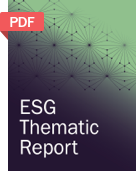Environmental, Social and Governance (ESG) in the Handbag Industry
Integrating ESG into decision making and business strategies contributes to an effective due diligence and a better investment decision for the company as well as relevant stakeholders. The companies which fall under the handbag industry have been transitioning and addressing their sustainability progress and agenda.
The demand for handbags is driven by increasing brand awareness and surging number of women in workforce. Various stakeholders or consumers have been very much particular about material sourcing, whether the materials have any negative environmental impact ranging from fabric, lining, pockets, zippers or adjustable strap and embellishments. Preference for eco-friendly and sustainable handbags like vegan leather, plant-based and upcycled materials have been critical aspects for this segment. Many companies have made commitment for minimizing packages and plastic waste like PVC by specific target years. Circularity has also been a priority for companies to be incorporated within product and product packages to make changes in design and strategies intended to reduce packaging and product waste. Companies are also transitioning to sustainable leather by reducing waste as well as soil or water pollution by stopping usage of certain chemicals and preparation methodologies.
The United Nations’ Sustainable Development Goals (UN SDGs) is a comprehensive framework that helps companies in this market obtain a perspective on the impact of their products and operations on ESG parameters.
ESG Trends
The companies which fall under this segment have both environmental and social impact, starting off with responsible material sourcing (SDG 12- Responsible production and consumption) has been most crucial element for this segment as many companies have pledged and adhere to not use any restricted substances as per guidance like Product Restricted Substances List (PRSL) which is a commitment made to eliminate use of hazardous chemicals which can be present in finished products. Many companies have also focused on innovation (SDG 9- Industry, innovation, and infrastructure) like upscaling using eco-friendly, sustainable handbags which are plant based, vegan leather or upcycled material.
One of the leading companies in this sector describes a product called ECONYL which is a regenerated nylon fiber obtained from 100% pre- and post-consumer use such as abandoned fish nets and carpets. Gucci-Up program focuses on upcycled leather and textiles, in fact they have collected 500 Tons of leather in 2021. Most of the companies have made a commitment to not use any single use plastic and PVC throughout their manufacturing procedures. Another company has disclosed eliminating single-use plastic by 2025 and eliminating all virgin single-use plastics. In addition to this, few companies do have assurance of 100% PVC free from specific years. Companies have been utilizing such innovative strategies to implement circularity throughout their value chain.
ESG Challenges
Handbag segments have challenges which could be mitigated with careful and responsible business strategies. One of the main challenges for this industry is affordability; as most of the handbags are imported and used as a fashion statement, some of the premium products might be very costly and unaffordable. Moreover, authenticity of the products in some areas have been a big question mark due to the presence of identical first copy products in the market. Maintenance and repairing of such premium bags have also been a challenge due to lack of unavailability of adequate vendors throughout.
Growth of the Handbag Market
Overall, the Handbag segment has been an important segment majorly for women as a handbag is a key transporting personal essentials as well as used to fashion statements. The companies are transitioning in sourcing sustainable materials which are eco-friendly and have lesser environmental impact compared to leather products. The companies have a stable market as global handbag market size has been valued at 49.12 billion USD in 2021 and expected to have a compound annual growth rate of 5.8%.
Key Companies in this theme
• Louis Vuitton
• Hermès International S.A.
• Michael Kors
• Fossil Group, Inc.
• Gucci Gucci S.p.A.
• Prada S.p.A.
• Burberry Group Plc
• Tapestry, Inc.
• Chanel
• Compagnie Financière Richemont SA.
Scope of Handbag Industry ESG Thematic Report
• Macro-economic and ESG-variable analysis of the industry, including regulatory, policy, and innovation landscape
• Key insights on infrastructure developments and ESG issues affecting the theme
• Identify key initiatives and challenges within the industry
• Identify ESG leaders within the industry
• Understand key initiatives and the impact of companies within the sector to fuel an informed decision-making process
• Analysis of industry activities based on multi-media sources, including significant controversies and market sentiment
Key Benefits of Handbag Industry ESG Thematic Report
• Developing a comprehensive understanding of macro-economic, Policies & Regulations and innovations affecting the Handbag space, globally
• Key insights into environmental developments and ESG issues affecting the theme
• Identifying ESG risks and opportunities to business among leading players in the industry
• Obtaining a clear and relevant understanding of company actions, progress, and impact and find opportunities for investment into the sector


